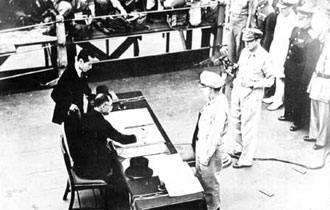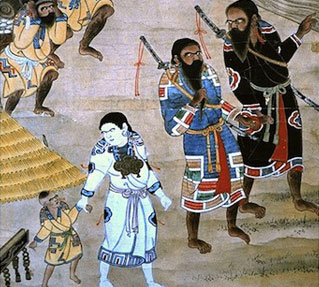Pages |
Recurring incidents such as the rape of a twelve-year old girl by three U.S. servicemen in 1995 increased the desire to expel the American military. When the Japanese government reduced the American military presence on the four major islands that constitute the Japanese "mainland," 75 percent of U.S. military facilities in Japan were concentrated in Okinawa. Okinawan resentment at this disproportionate burden rose to new heights. Historical grievances were revived. The case of Chibana Shōichi, who was tried for removing and burning the Japanese flag at an athletic meet in Okinawa in 1987, raised awareness of incidents in which Japanese soldiers sacrificed Okinawan civilians during World War II and reminded people of the discrimination that they had experienced in Japan. A former governor of Okinawa, Nishime Junji, noted that "although vis-à-vis Americans, Okinawans insisted that they were Japanese, they felt that in Japanese society, they were a different kind of people (ishitsu no mono) from the Japanese." When pressured by international human rights groups, the Japanese government insists, that "those who live in Okinawa prefecture or are natives of Okinawa are of the Japanese race" and hence cannot be the object of racial discrimination.
Although the Chinese community in Japan goes back to merchants who established trading posts in the sixteenth century, the number of Chinese residents in Japan remained very small until the twentieth century, when Chinese students entered Japan to study in its universities and military academies. After the Japanese annexation of Taiwan in 1895, Taiwanese also sought higher education in Japanese universities. In addition, the Japanese periodically recruited workers from Taiwan and mainland China to fill unskilled jobs and, during the 1940s, to work in construction and mining. Although many workers were repatriated during the American Occupation period, in 1975 there was still a Chinese community made up of restauranteurs, shopkeepers, and small businessmen that numbered approximately 68,000. Many Chinese had lived for several generations in Japan.
After 1983, the Education Ministry permitted more foreign students into Japan. This coincided with the "opening" policies of the People's Republic of China, and as a result a new wave of Chinese students from the PRC as well as Taiwan entered Japanese universities. The significantly higher standard of living in Japan also attracted illegal Chinese entrants (there were over 27,000 in 1991) and Chinese who overstayed their visas (over 25,000 in 1992).
The first wave of Koreans immigrated to Japan during the late fourth to seventh centuries. After Japan annexed Korea in 1910, many Koreans entered Japan in search of work. In 1930 about 300,000 Koreans lived in Japan. In 1939, with World War II causing labor shortages, the government ordered more Koreans to Japan and conscripted 350,000 Korean men into the Japanese military. At the end of the war more than two million Koreans were living in Japan. Although many returned to Korea, approximately 600,000 remained in Japan, where they were stripped of their citizenship and in 1947 were required to register as enemy aliens. Until 1965, when Japan normalized diplomatic relations with South Korea, the resident Korean community was stateless.
In the 1990s, Koreans were the largest single ethnic minority in Japan. Since the 1980s, they have enjoyed permanent resident status in Japan and are able to apply for naturalized citizenship. Studies of the group in the 1990s indicate that the political divisions of the 1950s and 1960s, when the community was internally divided into two groups mirroring the division of North and South Korea, linger but do not form the focal point of the lives of the younger generation. Despite continued cultural consciousness as a minority within Japan, rising rates of naturalization and intermarriage (in 1994, over 81 percent of Koreans marrying were marrying Japanese) point to their long-term assimilation into the Japanese population.
Pages |











